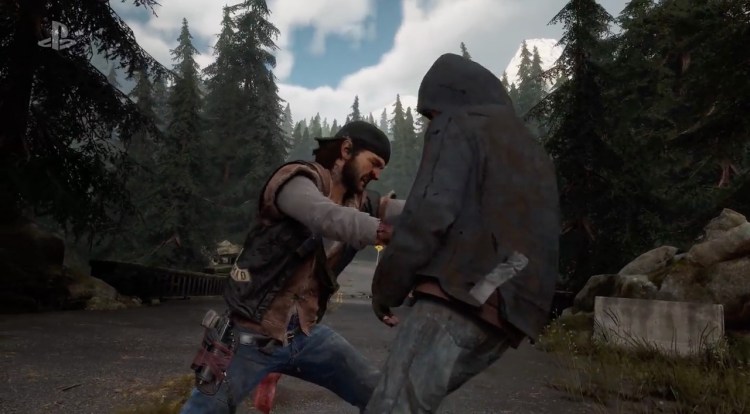Days Gone is one of Sony’s big games coming for the PlayStation 4. It had a riveting demo last year, and it showed up again as a much different game at the 2017 Electronic Entertainment Expo (E3) last week.
Last year, the hero Deacon St. John had to dodge hundreds of “freakers,” or really fast zombies, as they chased him around an old sawmill in the Oregon woods after a viral apocalypse. This year, developer Bend Studio returned with a marquee position in Sony’s E3 lineup, and it showed a different side of the game. In this case, Sony showed a trailer where St. John goes to retrieve a friend from a rival human gang. He is chased on his motorcycle by a freaker wolf, and then he gets ambushed by two human thieves. He kills them in a brutal way, sets a trap to distract more humans, and then finds his friend. He unleashes a bunch of freakers by blowing up a fence, and they chase the human gang away, leaving St. John free to kill the enemy leader and free the hostage. Just then, a freaker bear shows up.
I got a briefing from Bend Studio developers Ron Allen and Eric Jensen in a small group. Afterward, I played the game. In my demo, I was able to approach the human gang from another position, which showed you could attack the humans by sniping at them one at a time. It was a large level that hinted at a much larger open world. Afterward, I asked Allen and Jensen more questions. I’ve combined their answers in this edited transcript of our conversation.
They believe they’ve got a unique game, distinct from other zombie titles, because it has a unique setting in the Oregon woods with a wide variety of terrain. It features a wide variety of threats, from the freaker zombies to the freaker bears and wolves, as well as human enemies. On top of that, they say the motorcycle is like a character too, leveling up over time.
June 5th: The AI Audit in NYC
Join us next week in NYC to engage with top executive leaders, delving into strategies for auditing AI models to ensure fairness, optimal performance, and ethical compliance across diverse organizations. Secure your attendance for this exclusive invite-only event.
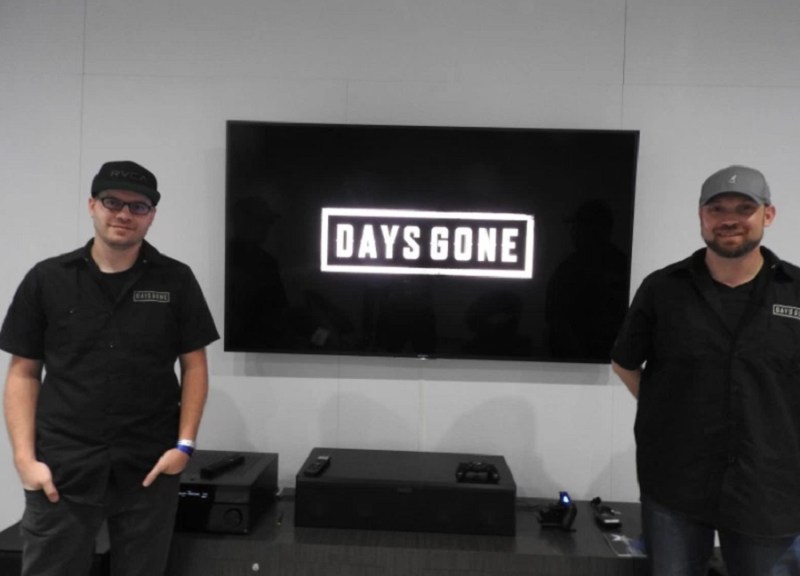
Above: Eric Jensen (left) and Ron Allen of Bend Studio, maker of Days Gone for the PlayStation 4.
Ron Allen: Days Gone is set in the beautiful high desert of the Pacific Northwest, which is pretty much our backyard. You play as Deacon St. John, a bounty hunter, who uses his unique skill set from his past as a member of a motorcycle club to help survive a dangerous world.
One is our real open world dynamic systems in play, which completely change your experience depending on the time of day and weather. You’ll notice it’s snowing, which is totally different from what you’ve seen. That affects things like visibility and motorcycle traction. It also affects how strong the freakers are. We also change up the time of day. This will take us from day to night and you’ll see the transition. That affects things like the marauders’ behaviors. It also affects the population. The freaks come out at night, basically.
The second thing we have is what we like to call strategic sandbox combat, our special way of saying that we give you the tools to play how you want to play. Depending on the situation, you’re going to have to change things up. You’ll notice, if you saw the media showcase, Deacon was distracted by these infected wolves, which we call runners. He got clotheslined. This time, because of the weather, those wolves aren’t there. Eric will slide by and you’ll see the guys running across and he’ll go around to pick them off from behind.
Also at the media showcase, you saw Deacon affecting the swarm. He had them come in and take out this marauder camp. Because of the time of day, in this demo the swarm isn’t there, so we’ll have to play in a totally different way.
Question: I noticed that you have the vision mode, kind of like detective vision from the Batman games, and you can mark targets. We saw those drag marks illuminated. Did you consider having something where, when you use the vision, things stay illuminated? So you’re not having to constantly turn it on and off?
Eric Jensen: In this demo, it’s the first time Deacon is using his survival vision. He has one skill unlocked, different from the media showcase, where you saw the ghost image of his buddy being dragged away. There will be other skills that progress his survival vision further.
Allen: Things like the drag marks may linger a little while.
Jensen: There will be tiered skill upgrades for that.
Question: That’s what the percentage in the upper right corner is for?
Allen: Yeah, that’s a level of experience.
https://www.youtube.com/watch?v=6uED22JERB8&t=211s
Question: The Pacific Northwest obviously has varying climates throughout the year. Does the game take place over a long period of time, and does the weather follow that?
Jensen: It’s completely dynamic. Depending on what your progress is in the open world and when you decide to take this mission, it could be snowing. It could be raining. It could be foggy, night, day. All that will play into how the mission plays out.
Question: What’s it like to balance that? How do you make sure the mission isn’t completely broken in the fog, say?
Jensen: Right. Because we have to do that kind of tuning for the open world, to make sure that nothing is too hard or too easy, we have a lot of development going into that.
Allen: It’s interesting, because living in Bend like we do — the weather in the northwest is extreme. It’s crazy. To give you an example, one day it was 90 degrees outside and we took our bikes up to the mountain, and when we got where we were headed it was snowing. It’s 10 minutes away. It hardly makes sense. We’re trying to emulate that.
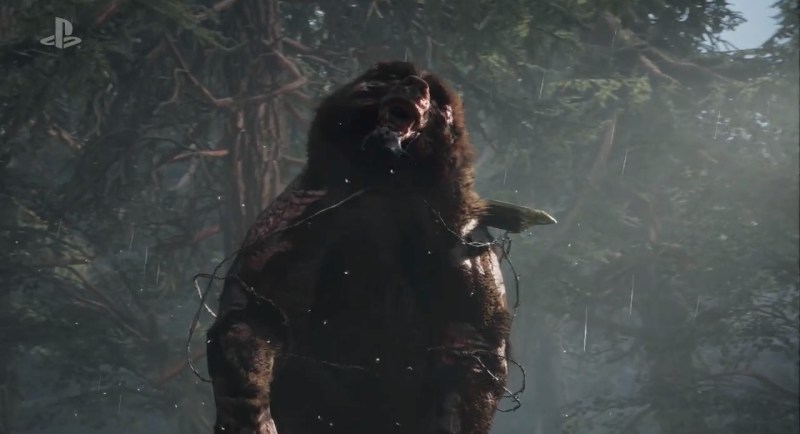
Above: The “rager” bear in Days Gone.
Question: I forget what you call that exactly, but was that a freaker bear?
Allen: Yeah, that was a bear. We have infected animals. In the media showcase demo, you may have seen the runners, the infected wolves. I hope you caught it, but those things are ridiculously fast. They can catch up to you when you’re on the motorcycle. That’s why Deacon was distracted and why he got clotheslined. This time the runners weren’t there, and that’s why he could evade.
All of our events are dynamic. You don’t have to go looking for danger down there. It comes to you. Depending on the time of day and the situation, things like that clothesline event may or may not be there.
Question: When you threw the Molotov and that guy got hit in the face with the axe, he lost a big chunk of his head, but he stayed standing. Is that going to be a factor in combat? Would a guy like that be impaired?
Allen: At one point — it’s a little overwhelming, with a lot of things going on at once, but you may have seen that Eric actually did an extremely hard hit, which affects the guy’s behavior. He hit the ground. But if you let him up — if you don’t mess with him any further, he may stand up. It does affect their behavior. We’ll show more in the coming months, but our AI does have—how to explain it? They have different levels of competence.
Question: At the media showcase, what stood out to me was how you used the swarm as a weapon, or a tool, in combat. Is that something you’re going to do a lot? Yes, these things can kill you, but they’re also, if you’re smart, something you can use.
Jensen: That was the coolest thing about what we showed last year – the horde, the hundreds and hundreds of them. The swarms are smaller groups, but with a similar mentality. If they see something, they’ll chase after it. Those swarms, on some occasions, will run across Deacon in the open world. You can be driving down the road and you’ll see them feeding off to the side. If they notice you, they’ll chase after you. Because that happens almost anywhere, when you’re doing jobs out in the open world, you can use those situations.
Allen: We have a living ecosystem. Depending on how you like to play, you can start to notice certain things—there will be a lot of things in the game you can learn how to use. That’s what we’re kind of trying to get across with that notion of strategic sandbox combat. It’s a special way of saying, “Use the world.” Whatever you find in the world, you can use as a tool.

Above: Deacon rescues Manny in Days Gone.
Question: The snow made this demo seem dramatically different. What other things can make that kind of difference?
Allen: We have rain, snow, time of day, and all of that affects pretty much everything. Like I said, there can more freakers on the way than what you saw. You have to be careful when you decide to do certain things, because they could be around.
Jensen: The weather can play in your favor, depending. In the snow, it’s going to be a little bit quieter as far as the sounds you make when you’re traveling, but you’re going to leave tracks out there. If it’s a downpour with thunder and lightning, that’ll mask some of the sound you make and you’ll be a bit safer.
Question: What’s been the biggest change in the game over the last year, between that demo and this one?
Jensen: We’re still moving toward the finish line. I don’t think anything has really changed. The biggest contrast to what we saw last year—we wanted to show the other side of the gameplay. That was our big set piece moment, showing off the horde. That can happen anywhere. But we wanted to show more minute-to-minute gameplay this time, what the player will actually experience more often.
Allen: We wanted to show something completely different, even though it’s the same game. “Change” isn’t quite the right word. We’re still marching toward the same finish line. But last year we wanted to show you Deacon running for his life, with thousands of guys after him, something completely crazy. We didn’t want to show that same thing this time. We wanted to show you a bit more of other things that we have in store, a bit more of our ecosystem.
Question: A couple of other games at the showcase mentioned 2018 or early 2018. Do you guys have any kind of date yet?
Allen: No, we’re not ready yet. We’re here, so that means something. But we’re just trying to march along. Bend Studio is an interesting place. We’re a relatively small studio compared to, say, the 400-man teams. We only just ramped up to 100 people or so. A little over 100 guys. It’s been fun to work on a game like this that’s set right in our backyard.
Question: How big an area does the open world encompass?
Jensen: We’re not going into numbers yet, but it’s quite large. Especially being able to drive around fairly fast on the bike. You’re not going to get anywhere immediately. There’s a lot of space to explore.
Allen: We’re creating a version of our backyard, like I say. One minute you’ll be in lush forests, then mountainous regions with waterfalls, and then the high desert, where there’s a lot of rock and nothing else. We’re trying to capture all of that.
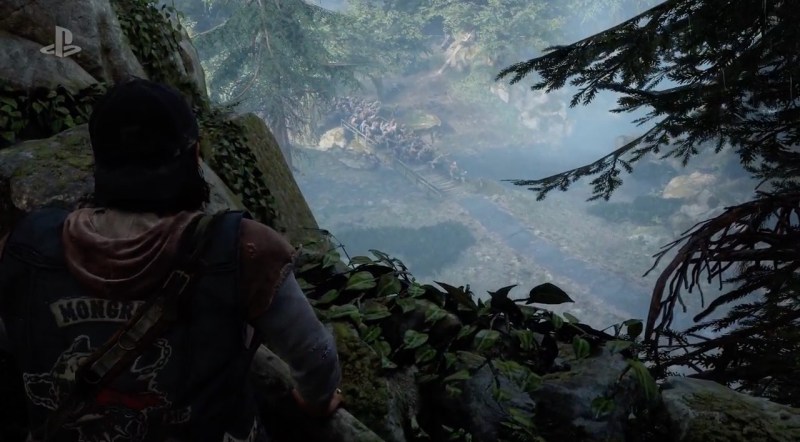
Above: Freakers down below in Days Gone
Question: I saw there was a gas meter when you’re riding the motorcycle. Does that run out quickly? How hard is it to find gas and things like that?
Allen: Gas is plentiful. You have to be careful, though, because like we’re saying, this is a dangerous world. One minute you can go and get a gas can and bring it back to your bike and it’s fine, the next minute you can have something after you. As you see with the experience and so forth, you’re working toward a better bike. I’m not going to say it’s a short time, but you work toward making it longer.
Jensen: It’s a valuable resource for anybody. There are people out there trying to get by. Finding fuel can be dangerous, but not every time. You saw the clothesline ambush. Other ambushes like that can happen in the world, and you never know when they’re going to happen. You might be trying to find fuel, and there’s a beautiful-looking gas can there ready to go, and you’re fine. The next time you see that, there could be guys there waiting for you. It always keeps you on your toes.
Allen: We also have damage on the motorcycle. Certain things, like when Eric went through the stream and it got kind of deep, can damage the bike. When the bike is fully damaged, you can repair it.
Jensen: The bike is a big thing for us. There’s not a lot of games out there – outside of racing games, or GTA with a few motorcycles – where a vehicle is this much of a character. It’s Deacon’s bike. It’s something he’s held on to from his past. Obviously he’s adapted it to the new world, because you can’t ride a stock Harley around the mountains off-road. But the bike is evolving as Deacon has evolved to adapt to the new world. It’s a main character in our story, alongside Deacon. Not a lot of games have that much focus on a vehicle or a motorcycle has this kind of key component to the game.
Question: Can you upgrade the bike as you progress? The guy you rescued in the demo is a mechanic. Can you craft new parts, weapons, anything like that?
Jensen: We’re not going to go super into detail about that, but if you look at the bike from last year’s demo, this one is a little bit different.
Question: How long after whatever happened is this story taking place?
Allen: Two years.
Question: Is the question of why this happened important to the story? Or is this just the world you wanted to tell a story in?
Allen: Last year we had a story trailer that gave some hints into the past and where Deacon was at before all of this happened. Why it all happened and where it’s going — you’ll find out more on that.
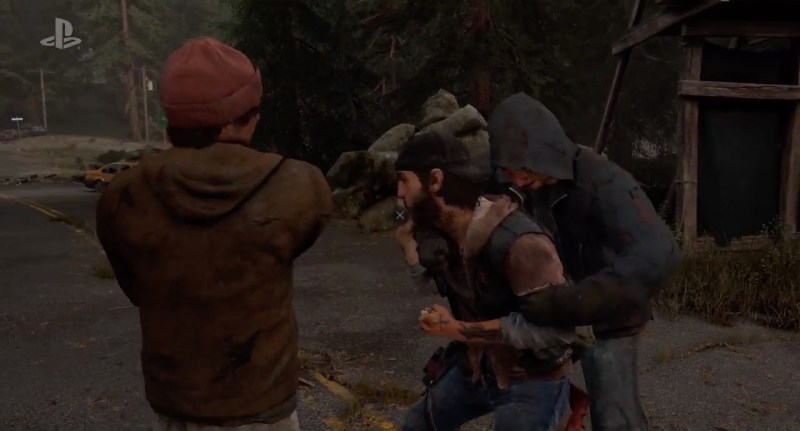
Above: Days Gone ambush
Question: You talked about gas cans being trapped, dynamic things like that in the world. Can we expect scenarios like that to be just an ambush with two or three guys, or can you run into something more involved, like tertiary characters out in the world?
Jensen: We have a huge variety of dynamic events planned out in the open world. Those can also cross over into jobs you do as well.
Question: There’s obviously a ton of zombie pop culture out there these days. Have there ever been situations where you have a great idea for a mission, and then you find out that happened on The Walking Dead last season, something like that?
Allen: It’s definitely tough to come up with unique ideas in this area. But we have a really strong design team. While there’s a lot of influence from other things, I think that with our living world and the freedom we have, we’re able to craft stuff that others can’t.
Question: You were talking about the wire around the bear. Is that supposed to be a fence wrapped around it, like it busted through the fence?
Allen: Yeah, that was an infected bear. He’s a little crazy. Not all of them will have that, but that one in particular did.
GamesBeat: Some of them seemed a bit like bullet sponges. It takes more than just one hit to bring them down.
Ron Allen: The weapon you were using — all the weapons you were using, in fact – they’re super early in the game. Later on you’ll get way more powerful weapons and be able to take things out with one or two shots.
Eric Jensen: With the freakers, when it starts getting dark like that, starts raining and getting colder, they’re stronger. That’s part of the dynamic weather system. When it gets cold, when you have snow or rain, and at night, they’ll get stronger and their numbers will increase.
GamesBeat: With the freaker bear — is there an animal apocalypse here as well?
Jensen: [Laughs] Yeah, we have an infected bear. We’re calling it the rager bear. We’ve also got the runners, the infected wolves. It’s definitely not just affecting humans.
GamesBeat: Where does all the food go if all the animals are infected?
Allen: Exactly. You got an idea — in both demos, you might have run across some plant icons on your mini-map. We use things like that to craft health and other items.
GamesBeat: It seems like stealth is one of your best choices going in, but at some point you have to be ready for all hell to break loose.
Allen: That’s the thing. We give you the tools to play how you want to play. If you want to use stealth, it takes longer and it’s harder, but if that’s your style you can play that way. What you could have done in that particular area was branched out a bit and lured some freakers in. Then they would have taken out the marauders for you. You can play the game how you want to.
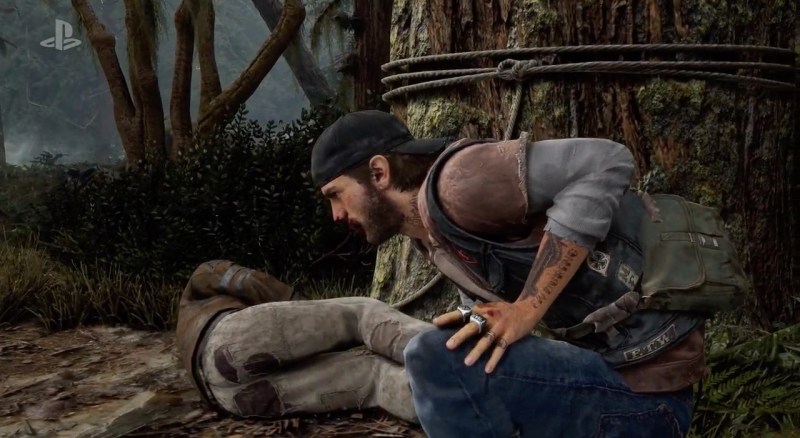
Above: Days Gone
GamesBeat: It seemed like you almost might be able to guide them, like a herd.
Allen: Right. You’ll get better, as you progress through the game, at manipulating these guys.
GamesBeat: That seems like a newer element compared to last year’s demo. You’re not always just running from them.
Allen: The thing about last year, we were trying to figure out what to show everyone. That was an extremely exciting moment. This time we wanted to show that it’s not just that. We have so much more in this game.
Jensen: Last year you weren’t expecting anything there. You didn’t know what was going on. Because you were caught off guard and unprepared, because you were distracted by chasing after this guy, the horde got the drop on you. You had no choice but to run and then fight for your life. In the media showcase demo we showed, you actually saw the horde ahead of time and were able to use them as a tool.
GamesBeat: The Last of Us had that element of hearing — listening for where enemies are. Do you have something like that?
Allen: Deacon’s a bounty hunter. You saw him using his survival vision to track. In our demo, you make it to where Manny’s bike was downed. You’re basically using your survival vision to figure out where they took him. You saw they dragged him off in this particular direction. How Eric was playing, he went down there, but then there was a sniper all the way down there. Now, you can go and fight in that direction if you want to, but Eric decided to go around the side. That’s when you saw the guy chained up. He broke the chain and came at you. Just to show you a bit more of how you can manipulate them.
Jensen: Like I mentioned earlier about Deacon’s survival vision, he’s honing this ability. He wasn’t a bounty hunter when he was a biker. But this has become a necessity in this world, to be part of these encampments and help people out. He’s started to develop this skill, tracking guys down, a kind of sixth sense.
GamesBeat: But he doesn’t entirely see things that aren’t there.
Allen: It’s interesting. The survival vision gets better. I don’t want to go into too much detail, because we definitely don’t want to spoil too much, but the survival vision gets better as you go on.
Jensen: That ghost image is one of the upgrades for survival vision.
GamesBeat: Will you have companions in the game in some way, or is he mainly a loner?
Jensen: Last year, in the trailer we showed, there were some other characters that we gave hints around. There are other people in his life. Whether or not they made it through all of this remains to be seen. But there are hints of that in what we’ve shown so far. You’ll find out more later on.
GamesBeat: You mentioned finding things to craft. How much scrounging is he going to be doing?
Jensen: Crafting is a huge component of the game. You craft a Molotov in this extended demo, and pull some branches from the trees to craft bolts for his crossbow. Finding materials and supplies around the world is going to be key. Ron mentioned the bike repair. You’re going to have to find materials to fix up your bike.
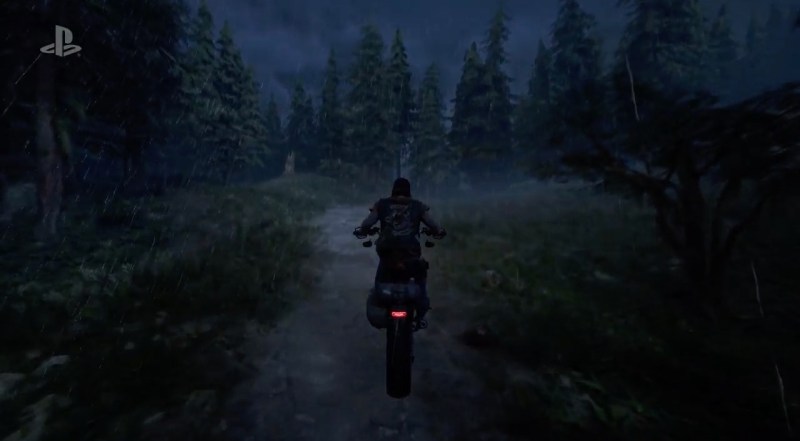
Above: The bike is a character in Days Gone.
GamesBeat: You mentioned the bike as a main character. You can level it up, I take it?
Allen: We showed Deacon gaining experience as you play through. Like I was saying, you saw damage and stuff on the motorcycle. Things like that can be upgraded.
Jensen: We hinted at that, when Deacon sarcastically mentions at the end of the extended demo that the only reason he kept Manny alive is because nobody else can fix his carburetor. Manny’s part of that encampment. He’s a tool for Deacon, to fix his bike up.
GamesBeat: The wolves are faster as freakers. Does that mean the human freakers are also faster than people normally could run?
Allen: Depending on the time of day and the weather, these guys are ultra-powerful. They are fast. What we showed last year, why you couldn’t just run away—Deacon manipulated his movement and getting away from these guys based on the environment. So he’s basically tripping them up. He’s constantly putting an obstacle between you and the horde. The easiest way to explain that—if there’s nothing between you and them, or you don’t have the motorcycle, these guys are fast. They can catch up to you.
GamesBeat: Do you have an expectation that the horde will only be so big at some point? In last year’s demo, it seemed like there was just no end to them.
Allen: There was. That, honestly, is one of our endgame scenarios. What we showed last year was very late in the game. What we’re showing this year—we have multiple things. We have individual swarmers or freakers. You can come across these guys individually and fight them. Then there are the swarms, the medium-sized groups, and the horde, which is what we showed last year, the massive groups. We have different sets. You saw, in the demo we did at the media showcase — Deacon put his hand up on the overlook and you could see there were a few hundred guys down there.
GamesBeat: There does seem to be some zombie fatigue out there. How do you try to stand apart?
Jensen: The freakers are just a sliver of the whole world here. Obviously we have the infected animals as well, to add some diversity to it. We also have regular animals and human groups like the marauders we saw. While it’s the end of the world, the world is very alive. A lot of things are going on and it’s all very dangerous. As Deacon’s traversing through the world, there’s always going to be something out there trying to attack him.
Allen: We have a living ecosystem in the game. The freakers are alive. They have all humanity stripped from them, but they’re still alive. They have to drink and eat. The thing we’re calling the meat wall that you went through—the marauders hung up these guys specifically to keep the freakers out. They’ll start feeding on those bodies and they won’t come in further. They play off that. You’ll even see these guys at streams drinking. We feel like that’s unique to us.
